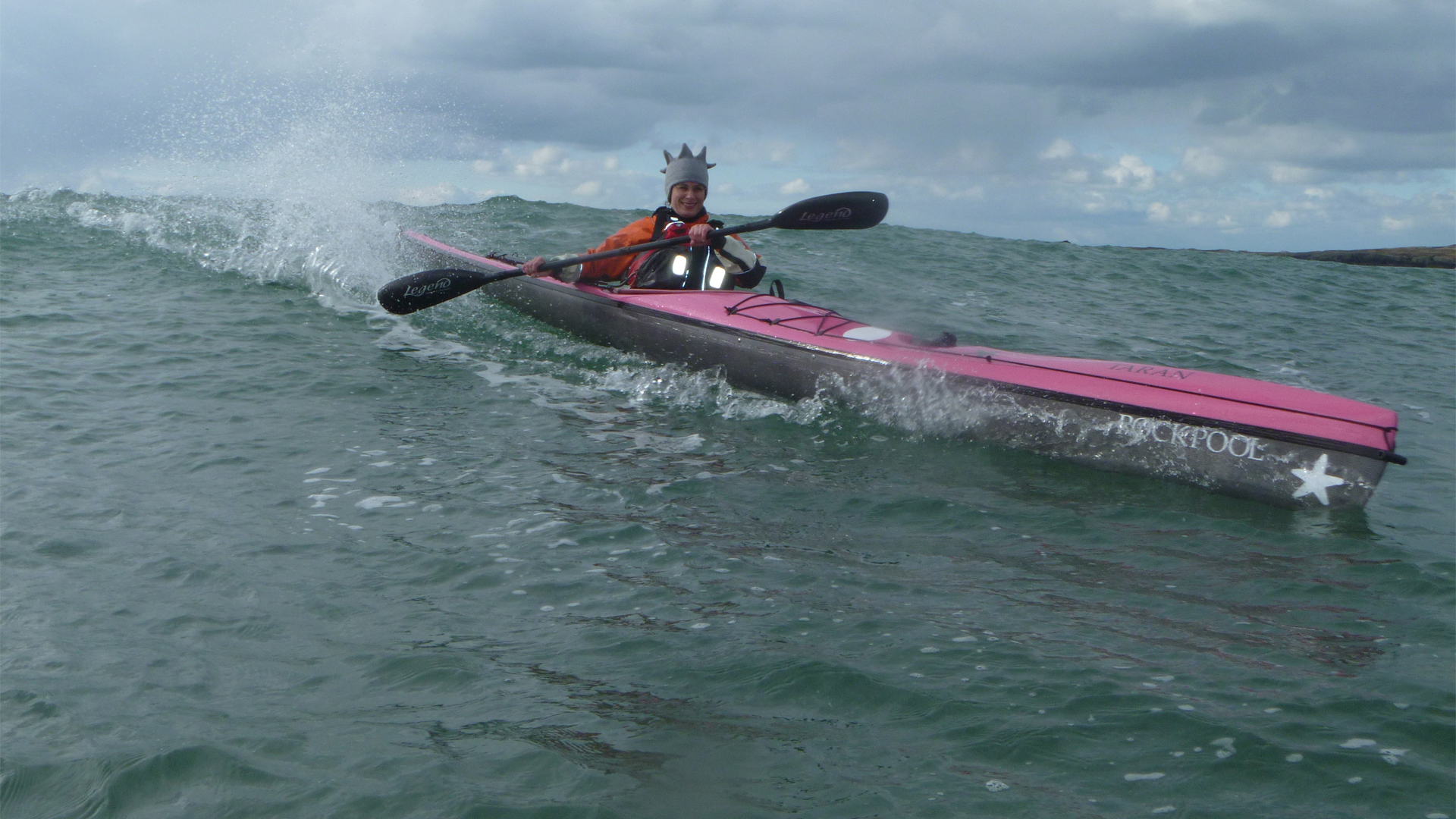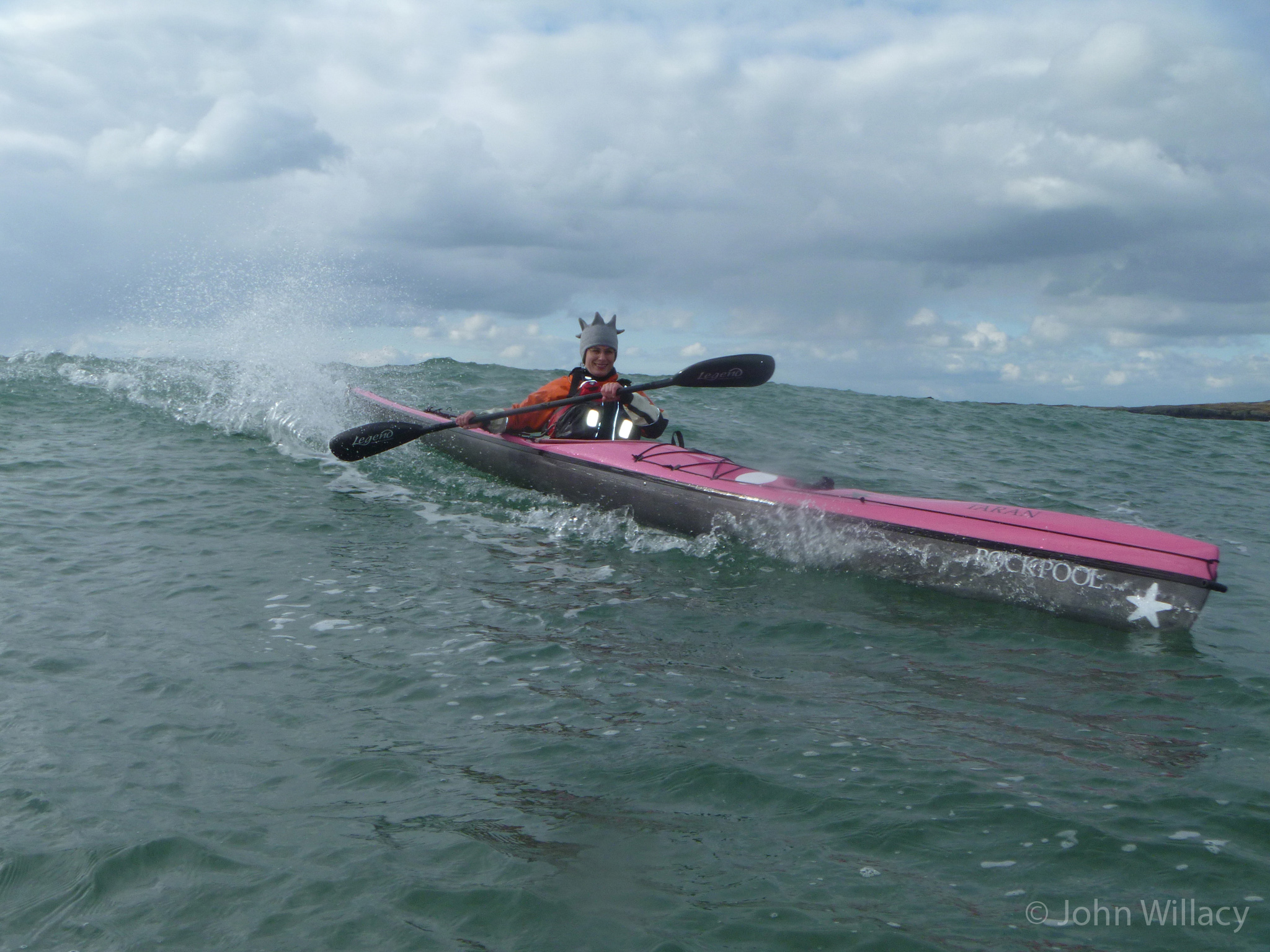by John Willacy
–
Before we go any further I should point out that this piece is written specifically from the point of view of blending sea kayaks and wing paddles together to gain sea kayak performance. This is not an argument for/against wings per se, nor is it a guide to wings for any other environment or discipline, it’s written specifically with UK sea kayak paddling in mind.
A question that is often asked on the edge of the Performance Sea Kayaking world is – should I paddle wings? Closely followed by – so which wings should I buy?
For me, the first was a question I asked when I was preparing for an attempt on the Anglesey Circumnavigation record in 2005. I had been paddling wings on white-water for roughly 15 years at that point, but I was still unsure whether they would provide a useful advantage in the specific world of sea paddling. The boats were heavier and slower and the waves came from more directions.
So first I asked around to see if I could find an answer. The underlying consensus was that they were not a good option for sea paddling – though nobody could really explain why. This left me a little confused, they were common place and worked well for racing on white-water.
So I dug a little deeper, and I came across various figures banded about: 2%, 10% even 15% faster than flats. Significant figures; however though I heard plenty of opinions I didn’t find anything to back up these figures.
Answering The Question
So I headed up to the lake with my sea kayak and a car full of blades – both flats and wings. There was only one way to find out the truth.
I set an out-and-back course on the lake, and using a heart rate monitor to paddle at a constant pace, I measured the time taken to paddle the course, repeating runs with different paddles. This wasn’t a great scientific experiment, it was just little old me with a pile of paddles. However as the test was repeated a number of times and over time, averaging out various factors, it did come up with a result.
For me, there was a measurable and reproducible difference between flats and wings. I measured a time advantage of between 4 and 6 % in favour of the wings, not huge but significant – 3 mins per hour, all things being equal.
So if we lay down the cash and buy a set, will they change our world?
Differences
A flat paddle blade (known as ‘flats’ in the racing world and sometimes as ‘European’ or ‘Euro’ style in the sea kayak world) is what most of us would know as a standard kayak paddle. The front and rear face of the blade is relatively flat, often with a central reinforcing rib running the length of the rear face. The blade face may be slightly curved both in cross section and longitudinally, but not greatly so.
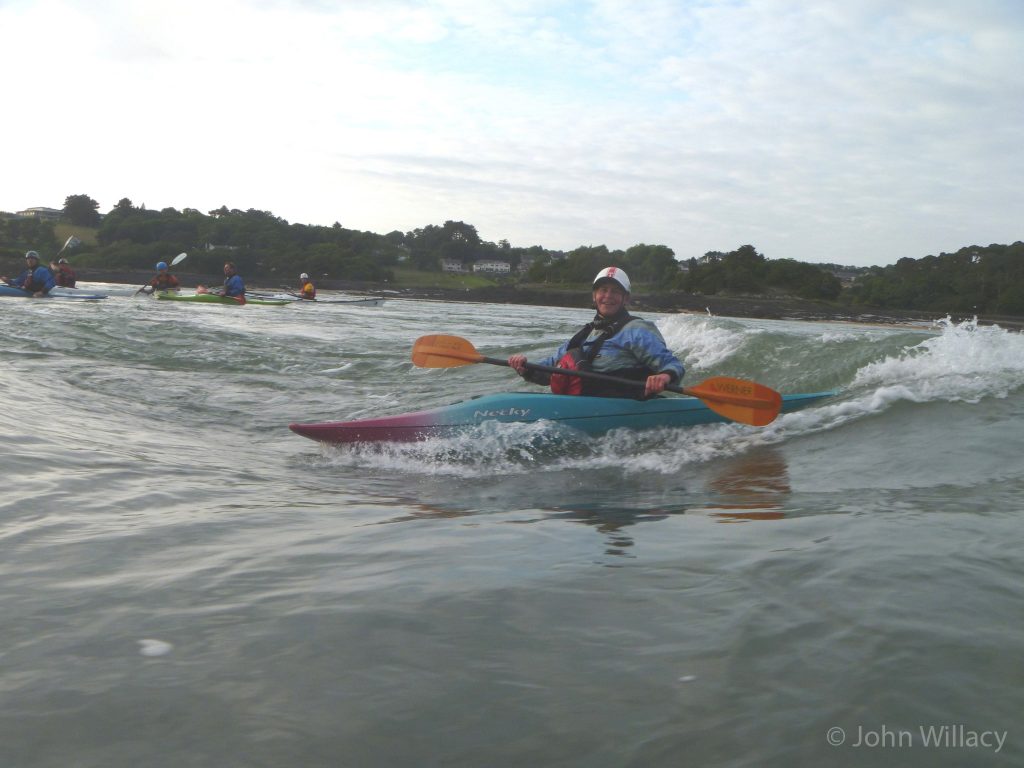
The difference with the wing blade is immediately obvious; the blade face is deeply curved in cross section with a concave drive face and a matching convex rear. There is a pronounced overhanging lip along the upper edge and no obvious reinforcing rib along the rear face. The blade looks a little like a stretched spoon.
The wing paddle evolved from the competitive desire for efficiency and advantage. The wing paddle was first developed by Stefan Lindeberg in Sweden, with the Swedish national team starting to use the paddle in the mid 1980’s. It quickly caught on across the racing world and is now de rigueur in both the flat-water and wild-water kayak racing disciplines.
How do they work? A little more detail…
Wings derive increased forward efficiency by reducing slippage of the paddle through the water and also by reducing energy wastage due to the ‘flutter’ of the blade. They also encourage the paddler to generate drive better from their torso rotation, so bringing larger muscle groups into play. This is really less of an efficiency saving and more of a effective use of body biomechanics in the forward paddling stroke.
You may hear stories of how wing paddles generate ‘lift’ or you may even hear that they move forward during the stroke. Look at that from a Newtonian perspective and cracks appear.
So wings tend to give an advantage for a couple of simple reasons:
- Flutter. The lip on the upper edge of the blade, combined with the convex cross-section of the blade, helps prevent uneven slippage of water across the blade and over the upper edge – reducing blade flutter. A flat paddle tends to allow water to spill off both upper and lower edges in an oscillation. More water spills from one edge than the other, this tends to introduce a twisting force on the blade. In turn this descreases the larger spillage but then increases it on the opposite edge. So the larger spillage alternates between blade edges. So the process introduces a small level oscillation between upper and lower blade edges which results in what is commonly known as ‘flutter’ on flat blades. The pronounced lip on the upper edge of the wing blade tends to force any ‘spillage’ of water vertically across the blade down to the bottom lip i.e. always from just one edge. This can then be balanced by blade entry angle and the paddle stroke of the paddler, and so minimises flutter.
- Grip. The lip and cross-sectional shape also minimise ‘slip’ of the blade through the water, further lowering losses from blade movement. The blades ‘lock’ into the water rather than slipping through it.
- A good wing paddling stroke will encourage the paddler to use torso rotation, and hence larger muscle groups during the stroke. This in turn will give greater power and spreads fatigue across larger muscle groups. This is arguably less of a paddle efficiency gain and more of a stroke effectiveness improvement. Either way you look at it though, it still gives a (slight) advantage.
The Stroke
An effective wing paddling stroke is a little different from a flat-blade stroke. It’s not difficult, just a little different. To some extent wing paddles guide the movement of the blade through the water themselves. They tend to move away from the boat as the stroke develops, matching the bio-mechanics of fixed arm paddling and torso rotation, encouraging rotation. This in turn encourages and benefits the use of larger muscle groups. Part of what is seen as wing paddling ‘efficiency’ is really a more effective use of the paddlers muscle groups.
Modern wing stroke and modern blade design has evolved to move the blades closer and more parallel to the edge of the boat. However wings still benefit from this obvious torso rotation.
The Ups and Downs
So let’s take a look at the advantages and disadvantages of using wing paddles over flat paddles. If we look at the modern racing world we see that virtually the entire field are using wing paddles, so they must be’ better’ surely? As is often the case, there is a little more to it than meets the eye.
Advantages
Speed. Going back to that advantage figure again of between a 4-6% advantage (let’s call it 5% say). So if you are out for a 1 hour paddle with your buddies, paddling wings will get you home around 3 minutes earlier – everything else being equal. That’s all, 3 minutes – not exactly something to write home about.
However if you are out in a one hour race, or paddling a 10 hour record attempt, then those same wings may get you to the finish line first, by a useful margin.
Stroke. A good wing stroke tends to involve larger muscle groups, in theory reducing fatigue and increasing stroke power.
Flutter. Wings reduce stroke flutter.
Grip. Paddlers also grow to like the way the paddles grip the water. In a performance sea kayak, flat-blades may feel ‘under-geared’ or as if they ‘slip’. Most paddler who give wings a realistic go, rarely go back to flats.
Disadvantages
But there are disadvantages:
As we heard wings are good for forward paddling strokes, after all that is what they are designed and optimised for.
However they are less effective than flat-blades at steering strokes, such as sweep strokes, stern-rudders etc. They are also pretty poor at slicing strokes – sculling-draw and bow-rudders for example. Rolling is also less effective with wings too, as is reverse paddling.
You could probably sum it all up by saying that wings give an advantage to forward paddling strokes, but at best no advantage, and often a disadvantage, to pretty much everything else.
Rough Water
Wings are different in rough water. Those less effective turning strokes can become significant here, and the fact that support strokes can become a little trickier isn’t exactly a positive characteristic.
Wings don’t lend themselves well to slicing strokes – ‘Double-pump’ bow rudders for example. They can also be a little trickier on surfing with stern rudders. Some wing designs (some more than others) tend to produce hydrodynamic lift when using them for stern rudder strokes when surfing, so they need ‘pushing down’ into the water, unlike flat blades.
Wings don’t take too well to allowing the blades to sink below the surface, getting them back out again can be awkward.
None of these factors is a great problem in it’s own right, but you need to be aware of them, they can catch out the unwary. If your life revolves around ‘gnarly’ days in big water, lots of falling in, surfing or just close in maneuvering, then life is may be more comfortable with flats on the whole.
Forward Stroke
Wings also need a reasonably high paddling style to work effectively; they do not work well with a low style. So if you drop to a very low style on a windy day, they may not give you any real advantage.
What few mention also, is the fact that for wings to be effective then you need to paddle at a certain pace. That does not mean that you always need to go at hairy-bears race pace, but you do need to keep the boat ticking along smoothly, with a tidy stroke, to gain the advantage. If you are out for a gentle bimble, chatting and taking life easy, then the wings are probably less efficient than a good set of flats. If this is predominately your sort of paddling, then maybe save your money…
The grip that is characteristic of the wings can become a downside too when paddling a sea kayak into a stiff headwind. The blades can feel as if they have been set in concrete, or suddenly doubled in size; after a while it can become fatiguing and in turn that wing paddling stroke becomes less effective – to the point that any gains may be negated.
Switching
How hard is it to switch between wings and flats? Well, with a bit of practice it really isn’t. A paddler with frequent experience of paddling both sorts of paddles should be able to switch between them and be paddling along happily within a minute or two.
Wing Blade Characteristics
Blade Shape –
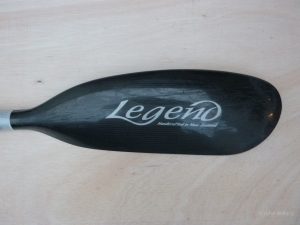
Basically this can be broken down into ‘parallel’ or ‘tear-drop’ type designs. Parallels may also be known as Rasmussen, while the Tear-Drop may also be known as Burton or Gamma. These terms basically refer to the way the upper and lower edge relate to each other. The parallel blades tend to be the older style of designs, while the tear-drops tend to be viewed as more recent designs, and more performance based. Both styles of designs are quite happily paddled on the sea and moving water; from the sea paddlers point of view the following factors tend to have a more significant effect on blade handling than the outright shape.
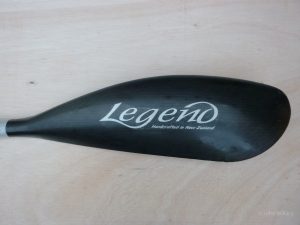
Layback –
This is the angle that the blade ‘lays back’ from the shaft – i.e. the blade is not a direct extension (or parallel) to an extended centre-line of the shaft. It is actually angled forward, away from the hands, so the tip of the blade lies ahead of the shaft centreline. Larger angles of layback tend to be found on flat water racing wings with an aim to give a better/cleaner entry and increased power transfer. From a sea paddling point of view, layback can make the paddles more unpredictable on moving water, and more awkward for stern-rudder surfing.
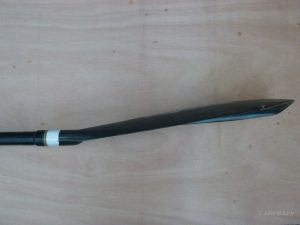
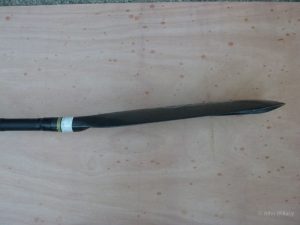
Twist –
A rotation along the length of the blade, so it is twisted a little like an aircraft propeller blade or a screw thread. Again the aim is to improve performance and power transfer during the stroke. Twist is less of a problem than layback on the rough stuff, but differing amounts of twist can make designs handle very differently from one another. An example of this is seen once again on the stern rudder where twist can give the blade hydro-dynamic lift, i.e. it may rise vertically out of the water when surfing – it can get tiring to always have to push it back down into the water. Some levels of twist can also make a blade more difficult to return to the surface when it has sunk below the surface.
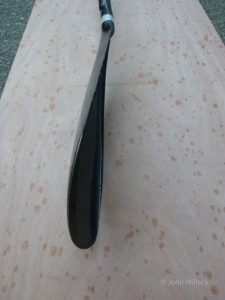
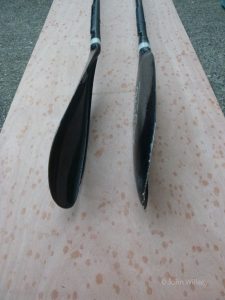
Lip –
The lip along the top edge of the blade tends to give the blade ‘grip’ in the water (along with pure blade size of course) – more lip makes the blade ‘solid’ in the water, less lip allows a little slip. Too much lip (and hence too much grip) is not a good thing. With a heavy sea kayak, into a strong headwind, too much grip can become uncomfortable – it becomes tiring as the stroke rate drops and places an increased strain on the joints.
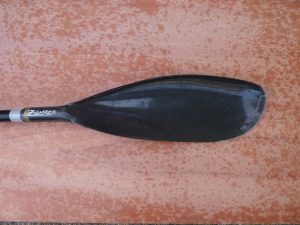
Tips –
If your wings become damaged at the tips it makes a big difference to how they enter the water and how much splash they make, so a metal tip can be a good idea. Some alloy/aluminium tips take the knocks well, but may also corrode badly in the salt environment, eventually causing delamination and ruining the blades. A stainless steel tip is expensive and a little heavier, but will make your blades last much longer. There are no corrosion problems with Composite tips either, but they do wear and if you hit rocks on a regular basis they are not going to last just as long as the metal ones.
Blade Choice
Blade choice for wings can become a difficult, time-consuming and possibly expensive affair. The wide variety of wing designs makes a much greater difference to the paddling experience than is the case with differing flat blade designs. Finding the right blade for you can be difficult.
General selection pointers
A blade that has been designed specifically for Wild Water Racing or Surf Ski Racing is often a good starting point as it usually has quite friendly/average handling characteristics. Some people paddle successfully with flat-water racing wings, but I tend to find they don’t take the knocks quite as well and, more significantly, they tend to be a bit of a handful on rough water. I tend to go for rather ‘average’ designs, leaving the more advanced ones for flat-water.
Wings will grip the water more than flats, after all that is what they are designed for, so go with a smaller rather than larger blade size if in doubt. Likewise a little shorter overall length, and a more flexible shaft is not a bad idea. I tend to avoid split shafts if I can; to me they feel too stiff and lifeless, and if they are too stiff they can cause injury problems.
Something to remember, and all-to-often overlooked, is the fact that as sea paddlers we paddle relatively heavy and sluggish boats on the whole. Wings are mostly designed with narrow, sleek, 10 kg (or less) craft in mind – responsive boats that glide and accelerate. So we need to tailor our wing choice to match the characteristics of our craft. Choose too large, stiff or ‘grippy’ blades and we may expect problems.
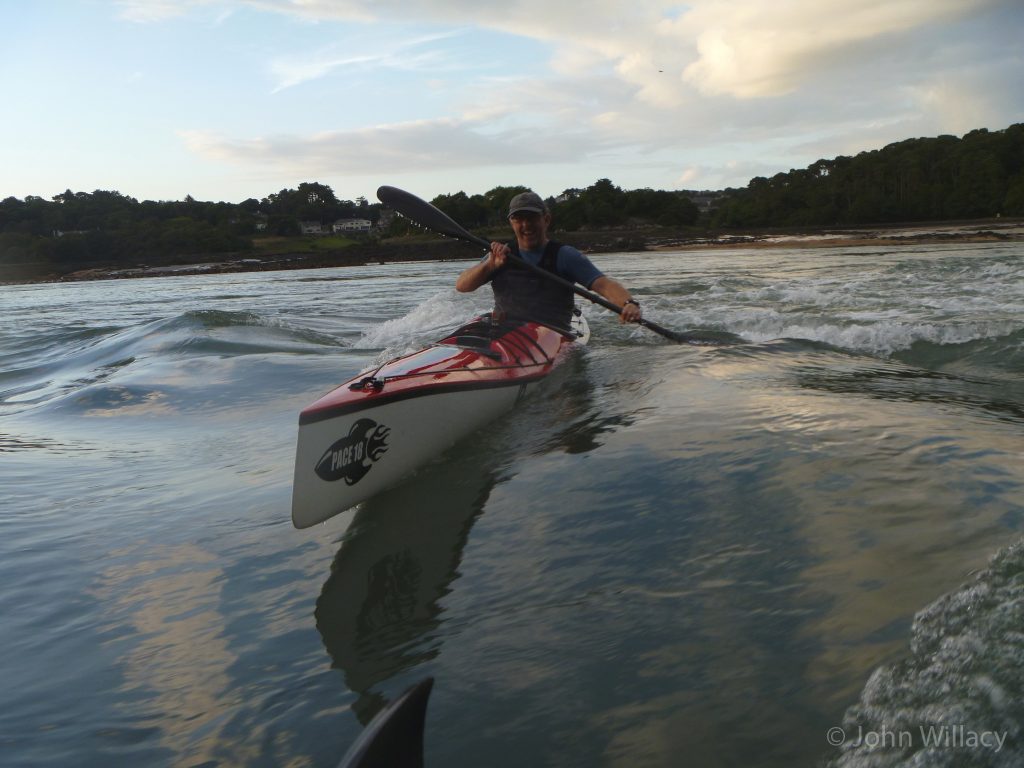
Summary
So are wings the choice for you? Well only you can make that choice…sorry.
Wing paddling is not difficult, but it does demand a certain level of skill and technique. It does bring advantages and reward but these may not be as significant as first thought.
Think back to the figures. Earlier we said that wings give around a 5% advantage. So for a 1 hour paddle we will arrive 3 minutes earlier with wings (everything else being equal), over 3 hours it will be around 9 minutes earlier. For that advantage we have to take a performance penalty on much of our stroke repertoire, including steering and rolling. Is it worth it?
That depends on our skill and what we have planned of course. If we have a 3 hour race or a 10 hour record attempt ahead of us then it probably is. If we are looking for expedition paddling, racing, records, fitness training or just all-round efficient cruising then wings are likely the way to go. Likewise wings can be an option to broaden paddling horizons or to help improve our paddling stroke.
However, if our paddling is predominately gentle cruising, group coaching or heavy white-water playing or surfing then those standard flats are probably the better choice.
Wings can be, and are, paddled successfully in all areas of sea paddling – rough and smooth. However it must be realised that they are just a set of paddles, there’s no magic involved here. Sometimes they will be the better choice, sometimes flats will be. You pays your money…
One thing that does stand out though, once a paddler gets acquainted with their wings, they rarely want to swap back.
John Willacy
June 2016
Updated 2024
